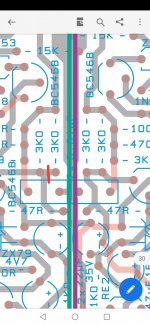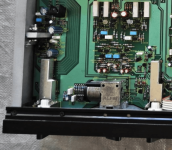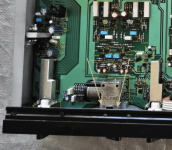There's a good overview of the PCB on page 16 of the service manual with clear identification of the test points and component location. It's not bullet proof, and there are slightly different versions of the PCB but if you have the training and experience, you should be able to identify and locate all components based on this. You can also read section 4.0 on functional tests. You really need to have some basic knowledge and experience reading diagrams and identifying components on PCB's. I can't teach you that or point to where you should look, you have to do it yourself, so if you do not feel comfortable with this, I suggest you consult a pro.
Problem #2 is that eight resistors in the power amp section are completely discoloured from heat. These are normal 0.25W 3K resistors feeding 12V zeners directly from the 40V supply rail and even though they are run in parallel to form a combined 1K5 resistor, about 0.35W is dissipated in each of the eight - and they are very hot. I have worked on many of these amps and it is a design issue that Audiolab have failed to rectify. Maybe they only have a a supply account for 1/4 watt resistors. First job I do is to remove the 1/4 watts and replace them with a single 3watt 1K5 making sure I stand it off the board.
I admire your patience in removing that selector switch. I recently bought an 8000S with the same selector problem and the seller was convinced that the internal gear was "slipping" and I needed to replace it with a metal one. Hence I got the amp very cheap. Proved to be the same problem you mention. grease on the selector contacts but I was in no mood to desolder that assembly from a double sided board. I discovered there are some small lugs on the front of the switch which once straightened allow the shaft to be pulled out and the gears removed. This also exposes the selector bank. You can't remove it but a good wash with contact cleaner solved the problem. In this case the plastic gears were fine and once reassembled it all worked fine.
The second switch bank you mention drives what Audiolab call a 'sense'. It does indeed mute as you change selections. I came to the conclusion it is a feature not a fault. As the remote control commands the motor to drive the input switch to your desired selection it may pass other live sources and without the mute would briefly feed those to the speaker. Yes, all rotary selectors do the same but manually we turn them quickly.
Agree it is a great amp.
I admire your patience in removing that selector switch. I recently bought an 8000S with the same selector problem and the seller was convinced that the internal gear was "slipping" and I needed to replace it with a metal one. Hence I got the amp very cheap. Proved to be the same problem you mention. grease on the selector contacts but I was in no mood to desolder that assembly from a double sided board. I discovered there are some small lugs on the front of the switch which once straightened allow the shaft to be pulled out and the gears removed. This also exposes the selector bank. You can't remove it but a good wash with contact cleaner solved the problem. In this case the plastic gears were fine and once reassembled it all worked fine.
The second switch bank you mention drives what Audiolab call a 'sense'. It does indeed mute as you change selections. I came to the conclusion it is a feature not a fault. As the remote control commands the motor to drive the input switch to your desired selection it may pass other live sources and without the mute would briefly feed those to the speaker. Yes, all rotary selectors do the same but manually we turn them quickly.
Agree it is a great amp.
Of course. I can understand enough. I had not looked in the service manual before, I found it online just now.There's a good overview of the PCB on page 16 of the service manual with clear identification of the test points and component location. It's not bullet proof, and there are slightly different versions of the PCB but if you have the training and experience, you should be able to identify and locate all components based on this. You can also read section 4.0 on functional tests. You really need to have some basic knowledge and experience reading diagrams and identifying components on PCB's. I can't teach you that or point to where you should look, you have to do it yourself, so if you do not feel comfortable with this, I suggest you consult a pro.
I think I have found the problem though. Like I described earlier I accidently soldered two resistors together and used a sharp knife to fix it. I see now though that it would not matter. Instead I have made a cut in the circuit. 🙄 See attached picture. I have marked with red paint where I cut.
It is easily fixed though.
Will look into it tomorrow.
Attachments
Is it ok to use 50v capacitors here instead of 63v? I only have 50v at home.There are 4.7uF caps as decoupling on the supply lines for each channel (marked yellow ing the cut out of the diagram). Do you mean those?
I have ordered 2W 1K5 resistors and will raise them well. Thanks!
Hi.Problem #2 is that eight resistors in the power amp section are completely discoloured from heat. These are normal 0.25W 3K resistors feeding 12V zeners directly from the 40V supply rail and even though they are run in parallel to form a combined 1K5 resistor, about 0.35W is dissipated in each of the eight - and they are very hot. I have worked on many of these amps and it is a design issue that Audiolab have failed to rectify. Maybe they only have a a supply account for 1/4 watt resistors. First job I do is to remove the 1/4 watts and replace them with a single 3watt 1K5 making sure I stand it off the board.
I admire your patience in removing that selector switch. I recently bought an 8000S with the same selector problem and the seller was convinced that the internal gear was "slipping" and I needed to replace it with a metal one. Hence I got the amp very cheap. Proved to be the same problem you mention. grease on the selector contacts but I was in no mood to desolder that assembly from a double sided board. I discovered there are some small lugs on the front of the switch which once straightened allow the shaft to be pulled out and the gears removed. This also exposes the selector bank. You can't remove it but a good wash with contact cleaner solved the problem. In this case the plastic gears were fine and once reassembled it all worked fine.
The second switch bank you mention drives what Audiolab call a 'sense'. It does indeed mute as you change selections. I came to the conclusion it is a feature not a fault. As the remote control commands the motor to drive the input switch to your desired selection it may pass other live sources and without the mute would briefly feed those to the speaker. Yes, all rotary selectors do the same but manually we turn them quickly.
Agree it is a great amp.
I have just replaced 4 of these resistors with 2w 1k5, the same that Anders used. Now that I looked at his picture he has only mounted 2 where there used to be 4 and you wrote that you replaced them with one 3w. Should I just use 2 instead of 4?
Remove each pair of 3K0 resistors and replace with 1 higher wattage 1K5. There are 4 pairs in all.
Pretty sure that the grease on the contact switches isn't the problem and it's a contact grease intentionally applied. Rather, the issue with the switches is that they're tarnished. Cleaning the contacts obviously solves that problem but leaving them dry risks longevity.
No, I use 3w, just make sure that are 1K5 ohmsThanks. Will it be too much with one 2w for each pair?
It's probably a mixture of both. From the colour of the gears I'd say they were heavily greased and Audiolab by design run hot inside the case. You're right it should be a good quality cleaner that contains a lubricant.Pretty sure that the grease on the contact switches isn't the problem and it's a contact grease intentionally applied. Rather, the issue with the switches is that they're tarnished. Cleaning the contacts obviously solves that problem but leaving them dry risks longevity.
Thanks. Yes they are 1K5 ohms. Replaced them yesterday together with some caps and now it plays perfect!🙂No, I use 3w, just make sure that are 1K5 ohms
I admire your patience in removing that selector switch. I recently bought an 8000S with the same selector problem and the seller was convinced that the internal gear was "slipping" and I needed to replace it with a metal one. Hence I got the amp very cheap. Proved to be the same problem you mention. grease on the selector contacts but I was in no mood to desolder that assembly from a double sided board. I discovered there are some small lugs on the front of the switch which once straightened allow the shaft to be pulled out and the gears removed. This also exposes the selector bank. You can't remove it but a good wash with contact cleaner solved the problem. In this case the plastic gears were fine and once reassembled it all worked fine.
That sounds like a very good alternative way to access the selector bank! I trained hard for this job in my teenage years desoldering 74xx TTL's from old computers... Back then I destroyed lots of PCB pads and traces, and the PCB's generally weren't throughplated, fortunately the quality of the Audiolab PCBs is very good and with patience and carefully sucking out solder with my welleman desoldering pump/iron, it worked out well. This particular tool is very basic and not temperature regulated, only 30W so it doesn't get too hot. If I was to do it again, I would use good quality desoldering wick to get all the solder out from the throughplated holes. The plastic gears were fine in my case as well.
I agree on this. The clicking must have been a feature in the 90's. I've thought about putting a logic analyser on the PIC processor to see what exactly is going on in order to mimic it in a custom firmware. For no particular reason.The second switch bank you mention drives what Audiolab call a 'sense'. It does indeed mute as you change selections. I came to the conclusion it is a feature not a fault. As the remote control commands the motor to drive the input switch to your desired selection it may pass other live sources and without the mute would briefly feed those to the speaker. Yes, all rotary selectors do the same but manually we turn them quickly.
I've since gotten myself an 8000A because I wanted the MC input 🙂Agree it is a great amp.
Hello, I have been a faithful ... owner of 8000s since 2000.. I know - cheap, stubborn or both..I have encountered and tried to repair most of issues here . For switches luckily an annual deox 5 helps. The resistor issue : I have replaced pairs with 1.5 K ohm single equivalents ( Vishay Dale) offset about 20 mm from the board on ceramic legs. I have not yet replaced power supply caps. Pretty much all 47, 22 uf caps in preamp ? were out of tolerance and replaced
I have noticed that amp (or my ears) like these 4.7 uf caps for be of relatively high ESR - the first set I put in (very low esr) resulted in very harsh overly bright sound . Replaced with something not even meant for audio I think...but resulted in great and balanced sound....🤷
As to amplification I only use the S for pre-amp duty to 8000p so I didn't yet look into replacing other caps outside of this particular area. I'll let things settle for a couple of weeks and move on to either PSU caps or 8000P.
I have noticed that amp (or my ears) like these 4.7 uf caps for be of relatively high ESR - the first set I put in (very low esr) resulted in very harsh overly bright sound . Replaced with something not even meant for audio I think...but resulted in great and balanced sound....🤷
As to amplification I only use the S for pre-amp duty to 8000p so I didn't yet look into replacing other caps outside of this particular area. I'll let things settle for a couple of weeks and move on to either PSU caps or 8000P.
I want add one thing. After second time replacing 4.7 uf coupling caps i have attempted setting bias. It was not an easy task since results don't appear to be immediate. Well the final outcome at least is drop in temperature of amp heat sink from about 50C to about 32C. I am assuming that is a positive turn of events...again I am just a basic amateur : got service manual and couple of tools and since I am pretty crafty I was able to pull this off - and learned a little in the process. It was fun actually.
I have the same problem. Are you able to indicate on the picture whereabouts are the "small lugs" you speak of? I notice you're Kapiti Coast, small world, I run a computer support business there 🙂...I admire your patience in removing that selector switch. I recently bought an 8000S with the same selector problem and the seller was convinced that the internal gear was "slipping" and I needed to replace it with a metal one. Hence I got the amp very cheap. Proved to be the same problem you mention. grease on the selector contacts but I was in no mood to desolder that assembly from a double sided board. I discovered there are some small lugs on the front of the switch which once straightened allow the shaft to be pulled out and the gears removed. This also exposes the selector bank. You can't remove it but a good wash with contact cleaner solved the problem. In this case the plastic gears were fine and once reassembled it all worked fine.
The second switch bank you mention drives what Audiolab call a 'sense'. It does indeed mute as you change selections. I came to the conclusion it is a feature not a fault. As the remote control commands the motor to drive the input switch to your desired selection it may pass other live sources and without the mute would briefly feed those to the speaker. Yes, all rotary selectors do the same but manually we turn them quickly.
Agree it is a great amp.
Attachments
I no longer have the amp but looking at your picture I recall removing the front panel, then a secondary panel supporting the front controls, easing the lugs around that front casting on the switch which then comes out with the shaft and gears. I'll try and PM you as you are so close, cheers.Are you able to indicate on the picture whereabouts are the "small lugs"
Attachments
- Home
- Amplifiers
- Solid State
- Audiolab 8000S repair


